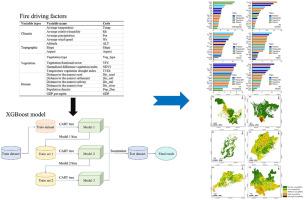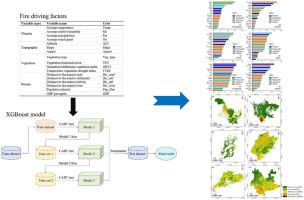评估中国不同森林生态系统的野火易感性和空间模式:综合地理空间分析
IF 10
1区 环境科学与生态学
Q1 ENGINEERING, ENVIRONMENTAL
引用次数: 0
摘要
了解火灾的时空分布特征及其驱动因素,准确预测火灾的发生,对有效的森林管理至关重要。因此,确定和预测易受火灾影响的地区至关重要,特别是在中国这样的环境和社会条件发生重大变化的国家。在本研究中,我们分析了中国不同森林生态系统中火灾的空间格局。通过结合RS和GIS技术以及机器学习方法,我们研究了影响火灾的因素,并建立了不同森林生态系统的易感性模型。为了生成火灾易感性图,我们采用了3种机器学习模型,即人工神经网络、随机森林和极端梯度增强模型,建立了火灾发生数据与气候、地形、植被和人为干扰等17个预测变量之间的联系。结果表明:不同森林生态系统的火点在空间上呈显著的聚类分布,且火点的驱动因素存在差异;我们观察到所有采用的火灾预测模型都有令人满意的表现。其中,极端梯度增强模型的AUC = 0.82 ~ 0.95,表现出较好的增强效果;精度= 0.79-0.87;召回率= 0.78-0.89;F-Measure = 0.78-0.86。黑龙江省的森林火灾主要由植被因素引起,而四川的森林火灾主要由人为因素引起。地形因素是影响山西、福建森林火灾发生的重要因素。在广东和云南,气候因子起着至关重要的作用。结合森林火灾因子,可以分析各生态系统火灾的时空格局,为区域森林火灾预警监测提供重要的科学信息。本文章由计算机程序翻译,如有差异,请以英文原文为准。


Assessing wildfire susceptibility and spatial patterns in diverse forest ecosystems across China: An integrated geospatial analysis
Understanding the spatial and temporal distribution characteristics of fires, their driving factors and accurately predicting fire occurrences are essential for effective forest management. Therefore, it is essential to identify and predict areas susceptible to fires, particularly in a country like China, where environmental and social conditions have undergone significant changes. In this study, we analyzed the spatial patterns of fires in distinct forest ecosystems across China. By incorporating RS and GIS technologies, and machine learning methodologies, we examined the factors influencing fires and developed a susceptibility model for different forest ecosystems. To generate fire susceptibility maps, we employed three machine learning models to establish connections between fire occurrences data and 17 predictor variables including climate, topography, vegetation, and human disturbances, namely artificial neural network, random forest, and the extreme gradient boosting models. The results showed that the fire points in different forest ecosystems showed a significant clustering distribution in space, and the driving factors of fire were different. We observed satisfactory performance across all the fire prediction models employed. Specially, extreme gradient boosting model exhibited superior performance with an AUC = 0.82–0.95; accuracy = 0.79–0.87; recall = 0.78–0.89; and F-Measure = 0.78–0.86. Forest fires in Heilongjiang Province are mainly caused by vegetation factors, while in Sichuan, human factors are the primary cause of fire incidents. Topographical factors play a crucial role in influencing the occurrence of forest fires in Shanxi and Fujian. Climate factors play a crucial role in Guangdong and Yunnan. The temporal and spatial patterns of fires in various ecosystems could be analyzed in combination with forest fire factors, providing important scientific information for regional forest fire early warning and monitoring.
求助全文
通过发布文献求助,成功后即可免费获取论文全文。
去求助
来源期刊

Journal of Cleaner Production
环境科学-工程:环境
CiteScore
20.40
自引率
9.00%
发文量
4720
审稿时长
111 days
期刊介绍:
The Journal of Cleaner Production is an international, transdisciplinary journal that addresses and discusses theoretical and practical Cleaner Production, Environmental, and Sustainability issues. It aims to help societies become more sustainable by focusing on the concept of 'Cleaner Production', which aims at preventing waste production and increasing efficiencies in energy, water, resources, and human capital use. The journal serves as a platform for corporations, governments, education institutions, regions, and societies to engage in discussions and research related to Cleaner Production, environmental, and sustainability practices.
 求助内容:
求助内容: 应助结果提醒方式:
应助结果提醒方式:


